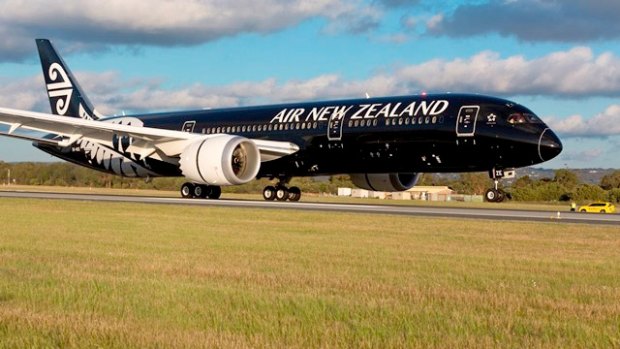By Candice Barnes
Fare-paying passengers had their first look at Air New Zealand's new pride and joy this week, after the Boeing 787-9 Dreamliner departed Auckland on its inaugural flight to Perth.
While some passengers were oblivious to the fanfare until they found themselves with a welcome mocktail in hand, others had long awaited the launch.
Chris McKeller drove 90 minutes from the New Zealand city of Hamilton to be among the first to pay for a return fare on the new aircraft. He said he planned to fly to Perth in economy class, spend three hours on Australian soil and return to Auckland in business premier.

Air New Zealand's first Boeing 787-9 Dreamliner touches down in Perth.
"I just like travelling and trying out products from a consumer point of view especially with the media hype, Boeing's hype and everyone else's hype about how wonderful this aircraft is," Mr McKeller said.
"I thought this is on my bucket list, I'm going to do it and it's very exciting."
The aircraft will now fly regularly between in the two cities. With a flight time of six to seven hours, the journey from Auckland to Perth sits on the cusp of medium to long haul travel.
It's a far cry from the world's longest flights, but long enough to be taxing on the body, and so the new creature comforts offered on board Air New Zealand's new 787-9 Dreamliner were more than welcome.
For a start, the windows were 30 per cent bigger, which immediately made the cabin feel lighter and brighter. One self-confessed "nervous flyer" said that alone made her feel more comfortable.
Those who missed out on a window seat (including yours truly) were still afforded a view outside, though not quite the view of the horizon Air New Zealand staff suggested could be enjoyed from every seat on the aircraft.
Gone were the window shades, replaced by a dark tint controlled by the touch of a button. Cabin crew could override this feature, and so would no longer have to disturb sleeping passengers prior to landing.
Perhaps the most noticeable difference was the noise – or lack thereof. When cruising, the sound inside the cabin was comparable to a relatively loud air conditioner.
The aircraft has also been designed to draw fresh air from the outside, which resulted in a more humid environment. It was five hours before dry eyes, nose and throat caused discomfort, compared to only two hours on the Boeing 777-200 (one of the aircraft which previously serviced the Auckland-Perth route).
The airline claimed the increased humidity could help reduce jet lag, and that the reduced cabin pressure (5500 feet, compared to the usual 8000 feet) also produced a similar benefit.
The business premier seats were identical to those on Air New Zealand's other newer aircraft, though the angle was slightly different than the 777-200. In-flight entertainment was the same – an 11-inch individual screen for each passenger – as was the flat bed, table and small footrest-turned-ottoman.
Premium economy felt roomier, and with good reason. The seats were more than an inch wider, but had the same pitch as the 777-200. Each passenger could recline up to nine inches, but the generous legroom meant that those behind still had room to eat, work and relax.
At 17.2 inches wide, seats in economy were slimmer than in the 777-200, but offered the same pitch and could recline to five inches. The in-flight entertainment screens were slightly smaller at nine inches, but offered the same impressive range of audiobooks, movies, television shows and music.
The economy seats also feature the Skycouch, a row of three seats that can be converted to a space slightly wider than a single bed. Air New Zealand set the cost at 80 per cent of a single business class fare, which would make it an attractive option for couples or those travelling with small children.
The Skycouch does lie flat, but is not equivalent to a flat bed. The total length is a little over five feet, but would still offer more comfort than a standard economy seat. 14 such rows are available on the 787-9.
While some leisure passengers may choose to forego the upgrades on the mid-range flight to Perth, the features may prove a worthwhile investment for those travelling longer distances.
Air New Zealand will take delivery of two more 787-9 aircraft in coming months – one will service Auckland-Tokyo while the other will service Auckland-Shanghai.
Air New Zealand 787-9 Dreamliner
Total seats: 302 (263 economy, 21 premium economy and 18 business premier)
Seat pitch: 30-33 inches in economy, 41 inches in premium economy and 79 inches (lie flat bed) in business premier
Row configuration: 3-3-3 in economy, 2-3-2 in premium economy and 1-1-1 in business premier
Entertainment: 9 inch seat back screens in economy, 11 inch in premium economy and business premier. All have in-seat power and USB port.
The writer travelled as a guest of Air New Zealand.
Sign up for the Traveller Deals newsletter
Get exclusive travel deals delivered straight to your inbox. Sign up now.